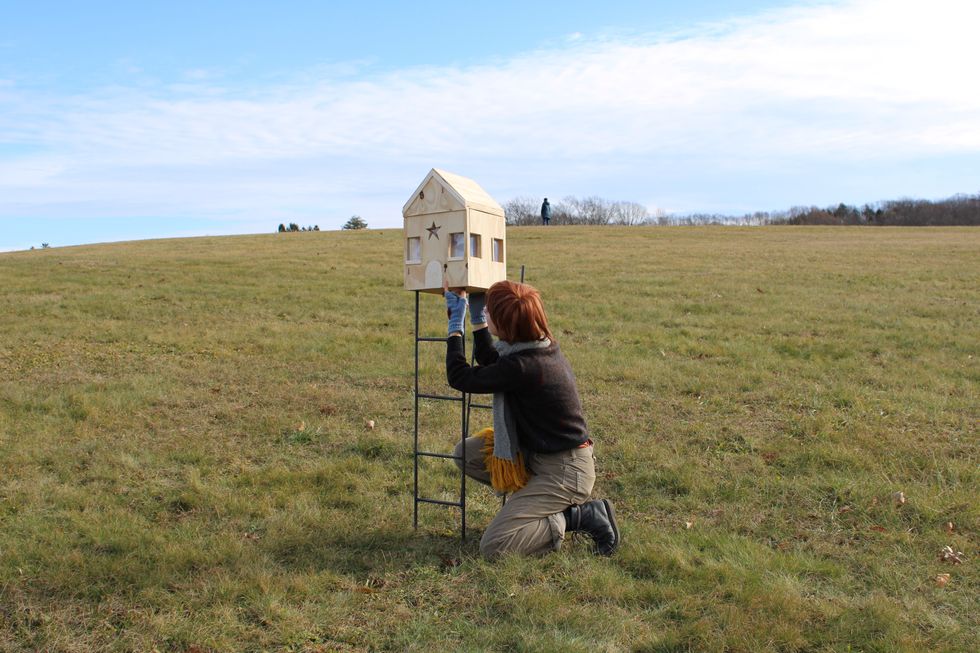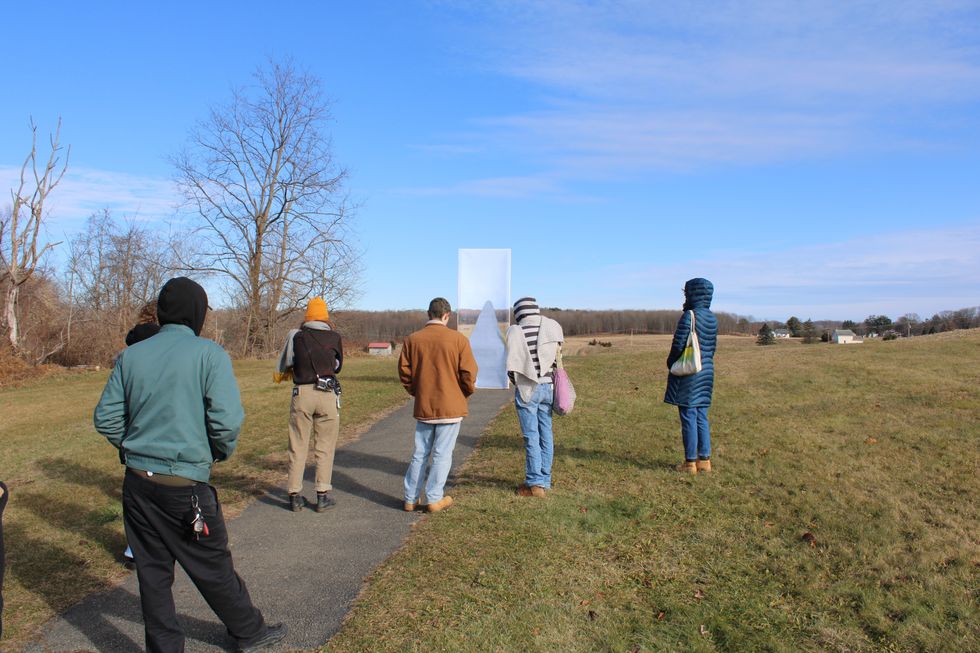Latest News
MILLERTON — The Town of North East unanimously selected Christopher Mayville to join its board at the start of its regular meeting Thursday, Jan. 11.
Mayville will fill the vacancy left when Councilwoman Meg Winkler was elected to a different seat with a longer, four-year term. Mayville, a Republican-endorsed candidate, lost to Lana Morrison and Winkler for the two four-year seats.
Town Supervisor Chris Kennan commented: “Chris has deep roots in the community, having worked with the village’s youth recreation program and also having previously served on the Webutuck Central School District Board of Education. Chris showed his sincere interest in being on the Town Board by campaigning for the job as well as by attending several of our meetings. I am delighted that he is now on the board. Welcome, Councilman Chris Mayville.”
The next item on the agenda was Kennan’s announcement of board committees. Between meetings, it falls to these committees to tackle the work of town government.
Kennan and Morrison will continue on the Budget Committee. Kennan and Ralph Fedele will be responsible for the Highway Committee. The Building and Grounds Committee, which has overseen the construction of the new garage and will focus on the new Town Hall next year, is Morrison and Winkler. Fedele and Mayville were appointed to the Cemetery Committee, which is involved in the restoration of the historic Spencer’s Corners burying ground on Merwin Road, and the Emergency Services Committee.
Hazard Mitigation planning will involve Kennan and Fedele as well as Bob Stevens and Ken Mclaughlin. Mayville and Winkler will guide the town’s Communication Committee.
The town’s involvement with housing will be headed by Kennan and Winkler. Fedele and Morrison will be in charge of the Personnel Committee, and Mayville and Morrison will coordinate recreation with the village. Kennan and Morrison will continue to work on the Wastewater District. Kennan, Morrison and Winkler will coordinate with the work of the Zoning Review Committee (ZRC).
In addition to board committees, Kathleen Spahn was added to the Climate Smart Task Force headed by Kathy Chow.
Kennan welcomed the new year and the new Town Board. He emphasized the collegial, collaborative working environment at Town Hall: “It’s a pleasure to be at work.”
The big projects for the new year will be the renovation and move to the new Town Hall, and the sewer project.
Housing in the Town of North East continues to be an issue, and Kennan promised to see what creative and constructive solutions could be implemented.
Also mentioned was the pedestrian bicycle plan the village is considering that will be put before the Town Board at its February meeting after consideration by the Village of Millerton.
On Jan. 2, 2024, the Town of North East held its first meeting of the year: the legally mandated annual organization meeting, which specified 25 appointments or designations for everything from the official newspaper — The Millerton News — to records retention policy, animal control and town appointed officials. The town’s official bank has changed from Salisbury Bank and Trust to NBT. The last item was the reappointment of Julie Schroeder to the Zoning Board for another five-year term ending in 2028.
There were no surprises, and policies and people remained the same as at the beginning of 2023. The town’s website is current and contains the positions, names and contact information of all town government members.
Keep ReadingShow less
A billboard by Bard College student James Wise was displayed at 3391 US-9 in Hudson from Dec. 20, 2023 - Jan. 17, 2024. Titled “How Long Will We Be Driving?”, the billboard questions the increasing dependence on artificial intelligence and its consequences. The billboard was part of Shandaken Projects’ public art initiative 14x48.
PHOTO COURTESY BARD COLLEGE
DUTCHESS AND COLUMBIA COUNTIES — A billboard with art by James Wise of the Bard College class of ’26 was on view at 3391 US-9 in Hudson from Dec. 20, 2023, to Jan. 17, 2023.
Titled, “How Long Will We Be Driving?”, the billboard came about through a partnership with Bard Community Arts Collaborative, the Center for Civic Engagement at Bard, and Shandaken Project’s Public Arts Initiative.
Wise’s piece was chosen from projects done by students in an extended media studio course at Bard College taught by Julia Weist.
Her students made 2D projects that were reviewed by Shandaken, and 3D projects that were reviewed by the Village of Red Hook’s chair for the Public Spaces Initiative Committee.
The 3D works were installed at Richard Abraham’s Memorial Park in Red Hook. The pieces ranged from interactive sculptures to large-format photographic prints to sculptures of wood and metal. This exhibit was not open to the public; it was a pilot program with the idea of future collaborations in mind.
Student Elena Schneider ’27 said, “Being able to make something to be displayed in the landscape where we live pushed me to create something I really care about and am proud of.”
Of the class, Weist said, “If you can create art that affects a viewer, moves a viewer in the parking lot of a grocery store, which is where our billboard project is located, you’ve succeeded profoundly as an artist.”
Wise’s piece was selected for the billboard outside of Hudson by Shandaken as part of its Public Art Initiative 14x48, which has exhibited “new work by contemporary artists across New York State since 2021.”
The title refers to the increasing reliance of society on artificial intelligence (AI) and the potential loss of human independence with such things as self-driving cars, Wise has explained; it questions the very use of cars in the face of global warming. The figure at the center of the work, an avatar created with AI, reminds viewers that AI is a field dominated by white males.
Explaining his approach to the work, Wise said: “My main concern was in conveying my concept as clearly as possible. I wanted the billboard to blend in, so I researched local insurance billboards for a base.” He added: “After layering and collaging the AI images I’d generated from various local insurance-themed prompts, I ended up landing on the final product. I was always cautious to keep my work as close to the source material as possible, while still subtly distinct under closer inspection.” Wise created the billboard by layering more than 50 AI generated images.
Keep ReadingShow less
Why are so few films set in CT?
Jan 17, 2024
In her new book from Lyons Press, actress Illeana Douglas deftly chronicles a fictionally neglected state in “Connecticut in the Movies: From Dream Houses to Dark Suburbia.” Full of deep cuts and an entire section dedicated to Yale University making brief appearances in film — Indiana Jones lectures at a fictional version of the college, but we all know globetrotting Indy is a New Jersey man — it becomes clear that a book with the same attention to minor detail about New York or Boston movies would have to be three times as long.
Why does Connecticut, a state in such close proximity to New York City — in the heart of New England, a region where Nathaniel Hawthorne, Edgar Allen Poe, Louisa May Alcott and Henry Wadsworth Longfellow helped solidify American fiction — have so little to show for its cultural canon? Even Hartford’s crowning historical site, The Mark Twain House and Museum, celebrates an author whose best-known masterpieces are set in Missouri, waxing on “half-forgotten Southern intonations and elisions.”
In terms of material to adapt, Yale does not have its alum-penned collegiate novel to hold up next to “This Side of Paradise” (Princeton), “Love Story” (Harvard), or “The Group” (Vassar). Neither has Connecticut had its populist hometown laureate mining its culture for the masses like Stephen King did for Maine or John Irving for New Hampshire. Certainly, the most famous piece of fiction set in Connecticut is Amy Sherman-Pallidino’s television series “Gilmore Girls,” inspired by the Californian writer’s brief visit to Washington, Conn. Set in an imaginary Litchfield County-type town filmed on a studio set in Los Angeles, the robust ensemble of verbose and anxiety-inducing residents — class-conscious, parochial meddlers — are satirically rendered as they belligerently assault each other’s character in the echo chamber of weekly town ordinance meetings. Small-town Connecticut, Sherman-Pallidino’s writing suggests with a gleeful smirk, is no place for privacy. Is it a place for happiness?
The magnum opus of literary Connecticut fiction is Richard Yates’ largely forgotten “Revolutionary Road,” the author’s debut that was a finalist for the 1962 National Book Award. Vivisecting the underbelly of suburban conformity, Yates’ bitter marital plummet into empty adultery and emotional paralysis served as the chief inspiration for Matthew Weiner’s Emmy-winning series, “Mad Men.” However, in the 1960s-set show, the frigid central family is placed in Ossining, N.Y, and Connecticut plays a minor role much later when a supporting character’s nightly commute to Cos Cob serves as the setting for an extramarital affair with a troubled housewife that ends with her undergoing electric shock therapy.
In examining the 2008 film adaptation of “Revolutionary Road,” along with Ang Lee’s “The Ice Storm” and Todd Haynes’ “Far From Heaven,” Douglas writes of the Connecticut period pieces: “Sometimes the dark storylines about adultery, insanity, abortion, alcoholism, racism, homosexuality, and wife-swapping are filmed so elegantly, or set against such sumptuous production values… that the savagery is muted by the beauty of the sets and photography. Women who live in modern glass houses or well-appointed mansions are imprisoned by circumstances they cannot escape, but their hair is amazing!” Key, she points out, is though each of these stories is dripping in destructive sexual activity, “There is no joy in it.”
More contemporary depictions of Connecticut can be seen in Jonathan Demme’s 2008 drama “Rachel Getting Married” and the 2005 Diane Keaton-led Christmas film “The Family Stone,” both caustic descents into dysfunction as an offputting outsider (Anne Hathaway, the black-sheep sister; Sarah Jessica Parker, a potential daughter-in-law) intrudes on a horrible family of smug liberals, resulting in a horrific time. Douglas quotes “Rachel” screenwriter Jenny Lumet (daughter of director Sidney Lumet) as barely apologizing for her indictment, “Sorry if you’re from Connecticut, but, ‘ech.’”
Perhaps the state’s proximity to Manhattan and its commuter railway — all the appealing traits a realtor would point out — has damned its fictional portrayal. Connecticut has become media shorthand for a stultifying caucasian bubble, a resting place for city men to dump their wives and children, a claustrophobic limbo for couples with enough money to own a home but not enough internal excitement to hack it in the big city. No one grows up in Fairfield County in the movies; it is a place you go when you want to feel rich.
This stereotype of Connecticut is used to opposite effects in the 1945 romantic comedy “Christmas in Connecticut” and in the 1975 and 2004 comedy/horror adaptations of “The Stepford Wives.” In the Christmastime crowd-pleaser, Barbara Stanwyck is a single Manhattan writer who uses the imagery of a fabricated Connecticut farm in her weekly column to sand off her rough edges and lull her readers with a placating false persona of a wedded homemaker. In “The Stepford Wives,” based on the novel by “Rosemary’s Baby” author Ira Levin, New York wives are moved to Fairfield County and brainwashed into conformity — becoming docile, serving homemakers.
Douglas devotes a good deal to the lush summer palette of 1986’s “The Swimmer,” starring Burt Lancaster and directed by Eleanor and Frank Perry (the late uncle to pop singer Katy Perry). The setting of the film was moved to Westport, Conn., by the suggestion of the directing team, but the short story published in a 1964 issue of The New Yorker by John Cheever focused its criticism on New York’s Westchester County. Like Don Draper in "Mad Men," Cheever spent his later life in Ossining. The preeminent anthropologist of WASP culture never wrote about Connecticut, targeting instead the upper-middle class peculiarities of New York’s Upper East Side and Greenwich Village and the suburbs of Westchester. That Cheever’s stories are synonymous with Anglo-Protestant Connecticut likely speaks more to the city’s influence on the state than its unique cultural identity. There are still plenty of Connecticut stories to be told, true of any American state, and the small canon of films and novels should not be a deterrent to writers but an open invitation to explore undocumented territory.
Douglas will discuss her book at Kent Memorial Library on Saturday, Jan. 20, at 2 p.m.
Keep ReadingShow less
A Swainson's thrush in spring.
Photo by Mick Thompson/Audubon
It has not been easy to work outdoors this winter thanks to the rain and melting snow. I am spending more time on social media, which I am not proud to admit, and have found several Facebook Groups – rather Facebook found them for me - that share information on native and invasive plants. The algorithm did good this time. I am rather hooked.
These groups include ‘Native plants of the Northeast’, ‘Native and Invasive Plants of the Eastern US’, ‘Propagating Native Plants’, ‘Invasive Plants ID and Removal in the US and Canada’,
‘Connecticut Native Plants’ and ‘New England Native Plant Seed Share/Trade’. Many within the communities are fierce advocates of native plants. They identify species almost competitively, the way someone might with the New York Times Spelling Bee, and offer suggestions on ridding invasive plants, propagating and planting native substitutes.
Recently, a community member shared a chart that put some data around a serious issue.
Berries of invasive plants do not offer the nutrition required by migrating songbirds. For birds that migrate south for the winter, a lot of fat is needed in their food to sustain them through their journeys. The research study behind this chart comes from a 2013 paper published in the scientific journal Northeastern Naturalist. Even though the study is now 10 years old the findings remain relevant and the issue it informs is more acute than when the study was published.
In addition to migrating birds, those that over-winter in our area require food with a high fat content to nourish them through the winter and into spring when they can rely on caterpillars (and, for the caterpillars to survive we need to plant the native plant they eat.) Sadly, birds in the wild are being malnourished due to the proliferation of non-native and invasive plants and their berries. Birdfeeders can only do so much.
According to the study, Japanese honeysuckle, Lonicera japonica thunbergii berries have less than 1% fat content. Compare this to northern bayberry, Myrica pensylvanica, a native shrub, at 50% fat. Remember tasting the sweet nectar from honeysuckle flowers as a kid? Perhaps the berry is similarly tasty to birds, but don’t eat a berry to find out; although the flowers are fine for human consumption, the berries are toxic to us. Japanese honeysuckle is basically junk food for birds.
The avian candy store includes berries from multiflora rose and buckthorn, with less than 1% fat, and autumn olive and oriental bittersweet at less than 3% fat. Compare with the native plants that co-evolved with local birdlife over millenia: gray dogwood has 35% fat, virginia creeper 34%, arrowwood viburnum and spicebush at 48%. These plants have been largely replaced in our backyards, fields and woodlands with non-natives and invasives, adding to the decline of our bird life.
When a bird ingests a berry it also ingests the hard seed or seeds inside the berry. The bird’s digestive system removes the outer part of the seed and excretes it coated in poop fertilizer, greatly increasing the seed’s chances for germination. This helps to explain the rapid spread of invasive species.
Some of the berries of invasive plants have healthful benefits, providing a few useful nutrients for the birds, and even for humans. Invasive Barberry, Berberis Thunbergii, is a relative of the Barberry, Berberis vulgaris, that is used in Persian cooking. Both types of plants have sour-tasting berries that contain berberine, an antioxidant phytonutrient that has been shown to lower cholesterol and help control blood sugar in humans.
Autumn olive, Elaegnus umbellate, which comes to us from Asia, is a shrub or small tree that can produce as much as 30 pounds of fruit from a single mature specimen. The fruit contains many more times the lycopene levels than our main food source of this carotenoid — tomatoes.
Lycopene has been shown to inhibit certain cancers and protects against diabetes among other benefits of its anti-oxidant rich pulp. Harvesting the prolific number of berries from the autumn olive will help to reduce seed dispersal by birds so, if you decide not to remove the plant it is a good idea to collect as many berries as possible when they are ripe. There are many recipes for autumn olive condiments and dishes to be found online.
The berries of the Amelachier genus are being touted as a superfood in Canada, where the tree is called saskatoon (here we know it as shadblow or serviceberry). According to Web MD and a few other sources I have checked, the berries have plenty of vitamins and minerals as well as the kind of flavonoids that can help prevent blockages in our blood vessels and can protect our heart and liver. They are ripe when purple; not red, or they will be too sour.
There’s only so far a bird feeder will go to solving this life and death issue for the birds in our area; still, it can’t hurt. Planting more native shrubs that produce fat-containing berries is the only long-term solution to the winter nutrition issue. A health food pantry to replace the existing sweet shops in our backyards.
Dee Salomon “ungardens” in Litchfield County.
Keep ReadingShow less
loading
















